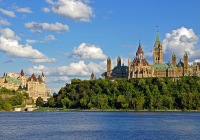
The country's capital sits on the south bank of the Ottawa River, opposite the French-speaking city of Gatineau in neighbouring Quebec province. It's location on the border puts it in the unique position of being truly multicultural and bilingual, with a harmonious blend of French and English culture.
Ottawa had humble beginnings as a small lumber town until Queen Victoria designated it the capital of Canada in 1857. Since then it has grown into a modern, cosmopolitan city, though it is often overlooked in comparison to its larger, more glamorous neighbours, Toronto and Montreal. Its main landmark is the 302ft (92m) high Peace Tower. The tower rises above the imposing Parliament Buildings, which stand in Gothic splendour at the junction of the Ottawa, Rideau and Gatineau rivers.
The city has a network of waterways and canals that link it to Lake Ontario and Georgian Bay. Locals and visitors use the historic Rideau Canal for boating in summer, and for ice sculpting and skating in winter. The parliament buildings and other sites have an old-world European charm.
Ottawa has numerous top-class museums and galleries. The city also has the National Arts Centre, which houses an opera company, theatres, studios and restaurants.

Travel Guide powered by Word Travels, copyright © 2023 Globe Media Ltd. By its very nature information in this travel guide is subject to change at short notice and travellers are urged to verify information on which they're relying with the relevant authorities. Neither Globe Media Ltd nor Travel Vogue can accept any responsibility for any loss or inconvenience to any person as a result of information contained above.